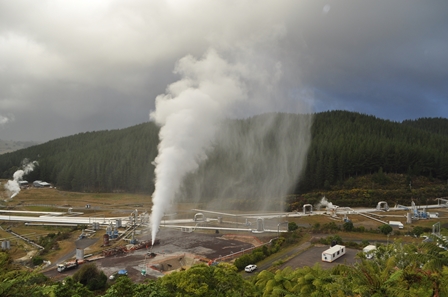 The United Nations Economic Commission for Europe (UNECE) and the International Geothermal Association (IGA) today signed a Memorandum of Understanding (MoU) to develop a globally applicable harmonized standard for reporting geothermal resources. Such a standard will ensure greater consistency and transparency in financial reporting and enhance management of geothermal resources.
The United Nations Economic Commission for Europe (UNECE) and the International Geothermal Association (IGA) today signed a Memorandum of Understanding (MoU) to develop a globally applicable harmonized standard for reporting geothermal resources. Such a standard will ensure greater consistency and transparency in financial reporting and enhance management of geothermal resources. Under this MoU, the IGA will work towards providing technology-specific rules of application (‘specifications’) for the application of the United Nations Framework for Fossil Energy and Mineral Reserves and Resources 2009 (UNFC) to geothermal resources. This work will be overseen by the UNECE Expert Group on Resource Classification.
The Director of the Sustainable Energy Division of UNECE, Scott Foster, noted “Application of UNFC to renewable energy resources is a priority area for our member States. Our relationship with IGA is an important step in achieving this across all renewable technologies.”
The President of IGA, Juliet Newson, stated “It has become apparent to the IGA that a lack of clear global guidelines and standards is holding back the assessment of geothermal energy as a viable energy option at a global scale. The IGA is extremely pleased to have established this formal cooperation with the United Nations. Having an international system and a standardized terminology for reporting geothermal resources will help build the trust and understanding of the geothermal industry with investors, regulators and the general public alike.”
Geothermal energy draws on the heat contained in the earth’s crust (temperature increases on average, by one degree every 30 metres). It can be harnessed from underground reservoirs of hot rocks saturated with water and/or steam, or from the heat of the ground itself. The energy can be used directly for heating or cooling, or converted into electricity.
In addition, the major advantage of geothermal energy over other renewable energy sources, such as solar and wind, is that it can operate nearly twenty-four hours a day, seven days a week.
Currently, generation of electricity from geothermal energy globally exceeds 12,000 MWe (Megawatt electric). While this is less than 0.25% of the current total electricity generating capacity worldwide, there is great potential for the development of geothermal energy, both for direct use of geothermal heat, and electricity generation, particularly in many parts of the developing world.
For example, at least 250 MWe of geothermal power is generated in Kenya today. This provides about 15% of Kenya’s total electric power generation, with growth continuing. Additional developments in East Africa, Europe and elsewhere can be accelerated through the adoption of global standards for assessing and financing projects.
Annex: Installed Geothermal Generating Capacity
Note to editors
The United Nations Framework for Fossil Energy and Mineral Reserves and Resources 2009 (UNFC), which is currently applicable to all extractive activities worldwide, is developed by the UNECE Expert Group on Resource Classification. The IGA is represented in the Expert Group and its Bureau. The Expert Group provides a forum for stakeholders, including governments, industry, the financial reporting sector, international organizations and professional societies and associations, to assist in defining the needs to be met by the classification, its definitions, specifications and guidelines, and a vehicle for recommending their application.
The work on application of UNFC to renewable energy resources is undertaken by a dedicated Task Force of the Expert Group. The Task Force has developed generic specifications for applying UNFC to renewables and is now focusing on the development of renewable commodity-specific specifications, including for bioenergy, geothermal, hydropower, solar and wind.
The International Geothermal Association (IGA), founded in 1988, is a scientific, educational and cultural organization established to operate worldwide. It has more than 5,200 members in over 65 countries. The IGA is a non-political, non-profit, non-governmental organization. The objectives of the IGA are to encourage research, the development and utilization of geothermal resources worldwide through the publication of scientific and technical information among the geothermal specialists, the business community, governmental representatives, UN organisations, civil society and the general public. One of the IGA's aims is to encourage, facilitate and, when appropriate, promote the coordination of activities related to worldwide research, development and application of geothermal resources. The IGA is a founding partner of the International Renewable Energy Alliance (REN Alliance).
For further information about UNECE, UNFC and IGA, please consult the respective websites: http://www.unece.org/ie/se/reserves.html and http://www.geothermal-energy.org